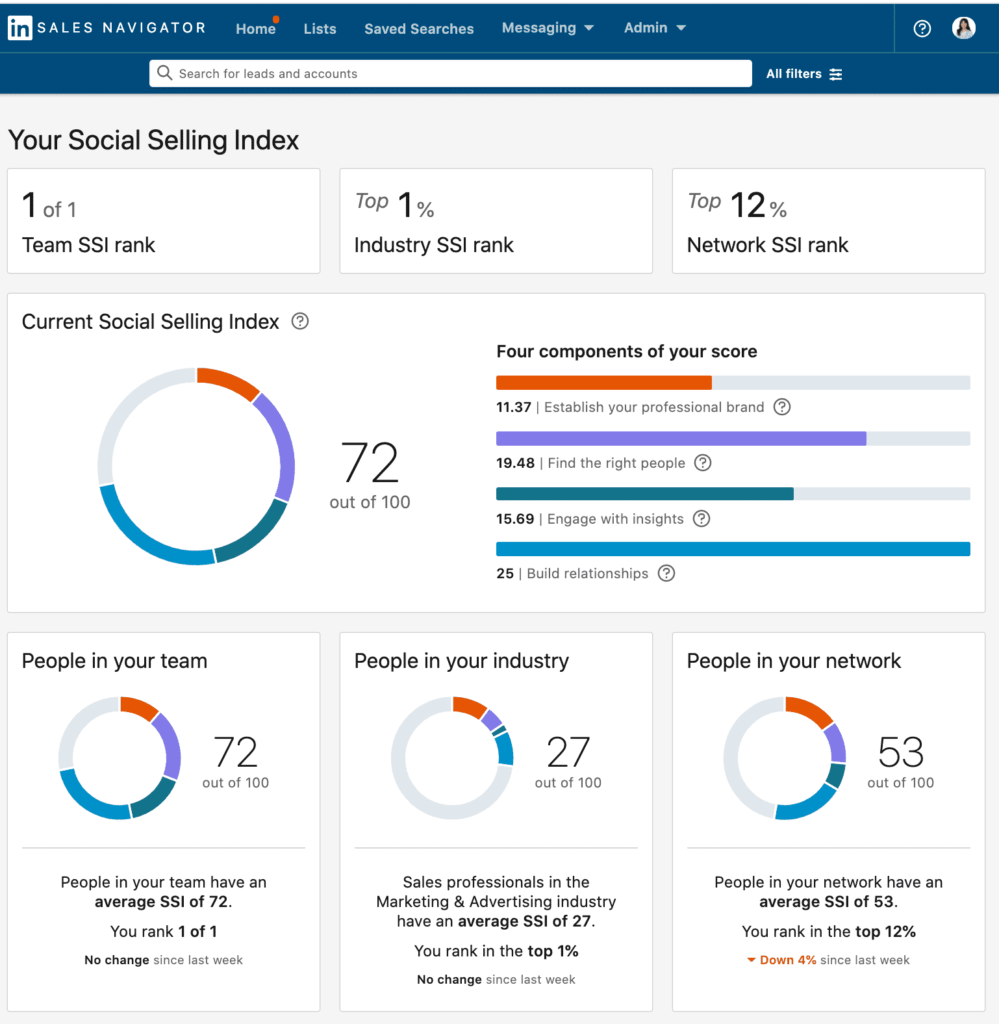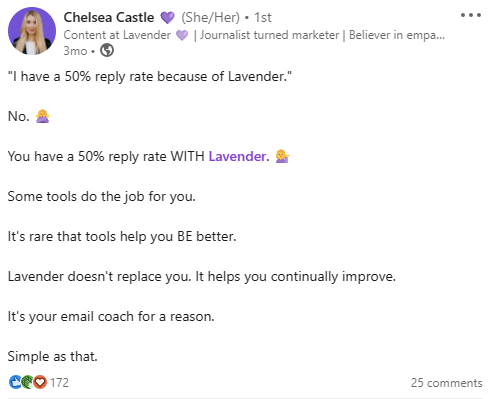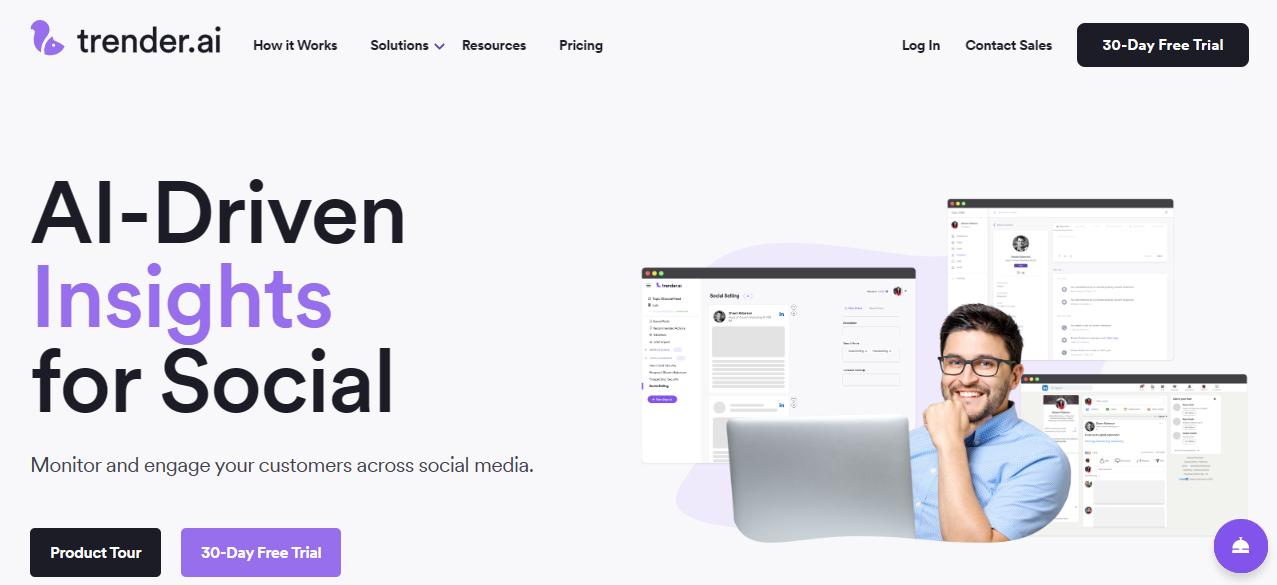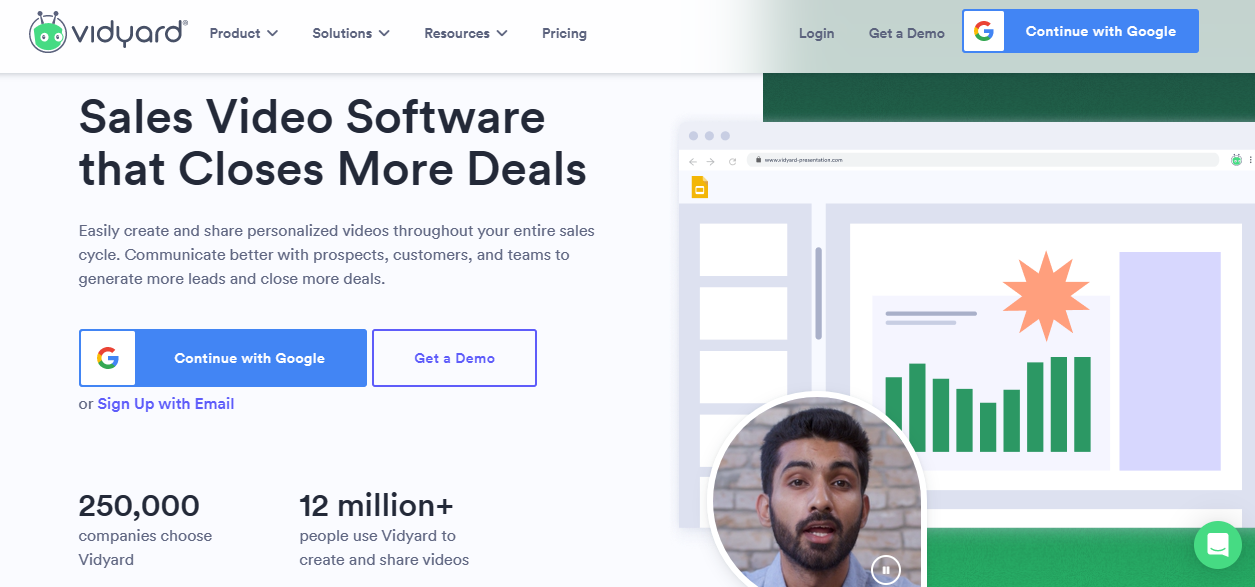What is social selling?
Social selling is a modern approach to sales that leverages social media platforms to build relationships, engage with potential customers, and ultimately drive sales. It involves the use of various social media channels, such as LinkedIn, Twitter, Facebook, Instagram. Social sellers establish a personal brand, connect with prospects via comments and direct messages, and provide value through relevant and targeted content.
The best social sellers prioritize relationship-building. They know how to create meaningful interactions and establish trust by actively listening to customers' needs and interests, reaching out at the right times, and sharing relevant insights in a consultative manner.
Because social selling allows for more personalized interactions, it increases the likelihood that target prospects will convert into customers.
What sets social selling apart:
Uses social media platforms as the main communication channel with prospects (as opposed to door knocking, cold calling, or cold email)
Combines elements of marketing along with sales (the best social sellers also create their own content)
Leverages available intent signals to identify the prospects most likely to convert (as opposed to targeting with ICP match alone)
What kind of companies can win with social selling?
Success with social selling is easier to come by for B2B companies than for B2C. In the B2B world, people are accustomed to using social media to chat with colleagues, third-party vendors, recruiters, hiring managers, etc. But in the B2C world, sending direct messages or commenting on people’s personal content can harm your brand. When receiving targeted outreach, consumers might feel that their privacy and rights are being infringed upon.
That’s not to say that you can’t use consumer-focused social media platforms for business relationships. For instance, Instagram isn’t the first platform you think of when you think of B2B social selling. But if your audience uses Instagram to sell to their audience, then it could be the best platform for you. For example, interior designers use Instagram to drive leads for their services. This makes Instagram a great platform for companies that target interior designers (think interior design software, small business bookkeeping services, etc.). Optimizing your Instagram account for this niche audience and engaging with interior designers can help you gain followers and establish meaningful B2B connections in a seemingly unconventional but effective way.
The benefits of social selling
So why even create a social selling program? These major benefits make it worth your while.
Book meetings with prospects easier
Social sellers connect with ICPs on social media, so they’re able to build that know-like-trust factor much quicker. Because of content published by the company, the social seller, and employee advocates, the seller is able to get past a target’s initial defenses. This can be especially important when trying to get in touch with business leaders and executives.
“The amount of touches it takes a strong social seller to book a meeting is typically less than it takes a traditional seller to book a meeting.” - Evan Patterson
Stay top of mind
It’s not always the right time to implement a new service or solution. Great social sellers stay connected with leads, so that when they’re ready to circle back, they remember (and trust) your brand—instead of a competitor’s.
Recruit great new talent
Not only will you ultimately drive more pipeline through social selling, but you’ll also prepare your company to attract new talent. For Gen Z, social selling is the future. They’d much rather forge relationships on social media than have to cold call people all day long.
“When I’m coaching people who are 18, 19, 20 years old, they’re not saying they want to be an SDR. They’re saying they want to be a social seller, community marketer, or B2B influencer.” - Evan Patterson
By implementing social selling into your organization, you can retain young talent. Your company will be a more enjoyable place to work, as sellers will be able to use the strategies they prefer while getting better results and commissions.
How to do social selling step by step
Follow these steps to create your own social selling strategy and implement it.
Step 1. Choose the platforms you’ll use for social selling
Everyone’s heard the advice that you should hang out where your audience is.
Let’s take this one step further. You should spend your time in the platform where your ICP is in the best headspace to book a meeting after a DM conversation.
For instance, if your ICP is on LinkedIn, Twitter, Instagram, and TikTok, you might decide to spend most of your time on LinkedIn and Twitter, because this is where they spend their working hours and are most likely to book a call with you.
Step 2. Optimize your social media profiles
Now that you’ve chosen your social selling platforms, it’s time to optimize your profiles.
Here are some best practices for the most popular B2B social media platforms.
LinkedIn profile optimization:
Write a profile headline that clarifies your title while adding value to your audience
Craft a profile description that speaks to how you can help resolve your target audience’s problems (instead of just a standard bio)
Upload a professional, on-brand headshot (consider using a colored background that matches your branding)
Upload a cover photo with an engaging headline and call to action
Twitter profile optimization:
Write a profile bio that shares how you can address your target audience’s needs
Add a link to your contact form or call scheduling tool
Upload a professional, on-brand headshot
Upload a cover photo with an engaging headline and call to action that matches your URL
Step 3. Find your target market on social media
Your target prospects are out there. But where?
Use this process to find real people in your target market:
Know the main pain points most relevant to your solution
Search those in social media
Find influencers talking about them
Read the comments to find prospects who also have these problems
Check their social media profiles to make sure they match your ICP criteria
There are also social selling tools that supercharge this manual work with account-based intent data to help you find prospects at scale. (Keep reading for our favorite software.)
Step 4. Reach out to initiate 1:1 conversations
Once you’ve found your target audience on social media, it’s time to start striking up conversations.
Whenever possible, customize your messaging to each specific prospect. For example, if they commented on an influencer’s post about a shared pain point, you might begin your message by mentioning that you noticed their comment. Then, ask how long they’ve been struggling with that issue.
Depending on what you’re selling, there might be a dozen different pain points that you could use to prompt a conversation. Pay attention to which ones are the most effective at eliciting a response and continue to use them.
Step 5. Engage with prospects’ content daily
In addition to reaching prospects through DMs, you should also try comments. The comments section on your prospects’ posts offers a great opportunity to reach people who might not be responsive to direct messages.
You can congratulate them for their achievements, show your support for their content, and respond to their requests for help or resources.
With LinkedIn Sales Navigator, you can save a list of all of your prospects and then check the feed from only that list of people. That way, you’re only spending your time commenting on their posts (instead of everyone you’re connected with). You might want to further separate your lead lists into low and high priority to help you make the best use of your time.
Step 6. Post your own content weekly
Through your DMs, connection requests, follows, and engagements, you’ll be building up a following of your target prospects. That means you have a captive audience of ideal customers. You should make the most of this opportunity by posting on your social selling platforms once or twice a week each.
If you’re not sure what to post, try hitting on these different areas:
Behind the scenes of your role, company, and/or industry
Career or business advice relevant to your target market
Your hot takes on industry trends and news
Personal learnings (such as work-life balance, confidence-building, etc.)
Step 7. Measure your success
And lastly, you’ll want to keep track of your social selling efforts so you can measure ROI and update your strategy accordingly.
The best way to measure your success is to use a social selling tool with attribution features like Trender. With their CRM integrations, you’ll be able to track which conversations led to pipeline opportunities (so you can show your boss that your time spent on social media is worthwhile).
A premium subscription to LinkedIn Sales Navigator unlocks the Social Selling Index, an automated measurement tool that scores you in four areas: your professional brand, your use of LinkedIn’s prospecting tools, your engagement, and your connections.
Here’s an example of the Social Selling Index dashboard from Expandi.

A high Social Selling Index score may or may not translate directly into leads and pipeline, so consider using this tool as a way of measuring your activity on LinkedIn. Make sure you have a separate software for tracking actual leads and attributing those leads to social selling. (Keep reading for our favorite social selling tools.)
Social selling examples
Check out these examples of social selling in action.
Sneakily promotional post
In this example, Chelsea Castle shows us exactly how to promote your solution—without being overly promotional. She shares how Lavender (a cold email AI writing tool) works with sellers like a personal coach.

This is also a great example because it uses a contrarian style. By negating a common-held belief and sharing an opposing point of view, you can drive more engagement and views for your content.
Supportive comment
In addition to creating your own content, you should be commenting on prospects’ and leads’ posts regularly. This comment from Kevin Marcus Miller is a great example because it’s well-written and has a positive, supportive tone.

Post-follow DM
One of the simplest forms of social selling is sending direct messages after someone follows your business account on social media. Messages like these ensure that your followers know about your offerings, and can help you drive more leads. For example, Night Owl Freelance Editing sends this message to new followers on Twitter.
Of course, you’ll have better results from sending personalized messages. But, if you’re pressed for time, you can kick things off with a templated message. For best results, make sure to clearly state your expertise and describe your services.
Question prompt
One of the best ways to start a conversation with a prospect is to ask a question. In this example, Mason Pastro asks a simple question about the prospect’s services.

Consider how you typically begin your discovery calls. The first few questions you ask to qualify a lead could all be great fodder for social selling DMs. For instance, you might ask if someone is already using a software category or certain strategy. Or you might ask if they have a certain role on their team.
Ultimately, the prompt question you ask should have the potential to segue into consultative advice for the prospect and lead qualification data for you.
Pro social selling tips
Dig deeper with these pro tips from social selling expert and coach Evan Patterson.
1. Know that emotions still rule in B2B
Evan says that although B2B is more complicated than B2C because of buying committees, the two sales environments are more alike than most sellers think. At the end of the day, the sales experience still comes down to emotions.
Great social sellers can play on emotions and pain points in their posts, comments, and DMs.
“A lot of people talk about the solution. They don’t talk about the pain. But misery loves company. Talk about why their pain and use derailing, blunt terminology about negative emotions they’ll relate to.” - Evan Patterson
2. Hire social sellers with the right personality
The best social sellers are the type of people who can go to a party where they don’t know anyone, make a bunch of new friends, and walk away with phone numbers and plans for hanging out.
“I look for people who have traveled on their own or moved to a different state or company. I look for people who are social, outgoing, emotionally self-aware, independent, self-motivated, and obsessively curious.” - Evan Patterson
The best ways to find such talent? Poach from other companies. Also, tell all your friends, family, and coworkers who you’re looking for. Chances are they know someone who’s the life of the party.
3. Support social sellers with killer community marketers
If possible, break social selling into two distinct functions. Community marketers can build audiences, engage with them, and create collaborative content and experiences, while social sellers focus on reaching out and driving pipeline through 1:1 conversations.
For best results, a company would have both roles filled, but if that’s outside your budget, you can hire one person to handle both responsibilities.
“The community marketer is a social seller’s SDR. We are warming it up for you. We are making it less cold. We’re those 16 billboards they see on the freeway before the salesperson knocks on their door.” - Evan Patterson
4. Make room in your sales strategy for social selling
Companies need to accept that when you start social selling, you might have a slight dip in pipeline for a quarter as your team upskills.
Leaders also need to realize that not everything can be measured. You can’t track every DM and voice memo. Instead, you should adjust your metrics away from emails and dials and focus instead on relevant meetings booked.
5. Track meetings booked with people adjacent to your ICP
A great social seller is a great networker. They know how to meet the right people in order to make new connections. This means that they’ll be booking meetings with people who are adjacent to your ICP. We’re talking about your ICP’s direct reports, coworkers, bosses, friends, etc.
Don’t put strict boundaries around the quotas for booked meetings. You should allow the meetings with adjacent folks to count.
This creates a supportive environment where social sellers feel like they can do their best work. And, you’ll end up booking more meetings with actual ICPs than if you were overly narrow in your approach.
6. Build your personal brand
“The best social sellers have a personal brand. So start looking at your career the same way an actor would. Everything I’ve done in my career has been on brand.” - Evan Patterson
Posting on social media is an essential part of personal branding, and your posts can fuel your success. The more that people already know about you and your company, the less your outreach will feel like a “pitch slap.”
To create a cohesive personal brand, use consistent colors in your graphics, write with a clear brand voice, and keep your content within 3 to 5 distinct categories.
Best software for social sellers
These social selling tools can help you identify your target audience, stay in touch with them, and pitch your products or services.
Trender

Trender is a comprehensive social selling tool that offers several essential features in one place. You can monitor all of your top-priority accounts across all social media platforms, get real-time insights on open deals, get notifications when your priority accounts are active on social media, and connect your CRM to accurately attribute leads to your social selling efforts.
Aware

Aware offers tools and insights for LinkedIn specifically. It offers a better feed for social sellers, because you can surface content from your top followers, prospects, and influencers and spend your time commenting on their content instead of random peoples’. You also get analytics to help you identify top-priority accounts and analyze the performance of your content.
LinkedIn Sales Navigator

With LinkedIn Sales Navigator, you get 40+ advanced filters to help you build accurate prospecting lists. You can then save your prospects so that you can see their content in one consolidated feed and comment on their posts. With their integrations, you can bring conversation data back to your CRM to establish a single source of truth for each prospect.
Oktopost

Oktopost is a social media scheduling software with employee advocacy features for B2B social sellers. This is a great platform for sales and marketing teams that are working together to push out more content across employees’ social media profiles. Marketers can provide approved content for sales reps to publish, and sales reps can write their own posts and send it to marketers for approval.
Vidyard

With Vidyard, social sellers can create personalized videos for every stage of the sales cycle—from the first DM outreach to the follow-ups it takes to seal the deal. Vidyard offers screen recording, video editing tools, and video engagement analytics.
Tip: Proposify integrates with Vidyard so you can add custom videos to your proposals!
Proposify

To convert leads from social media into paying customers, you need proposal software. Proposify helps sales teams to quickly send on-brand, personalized proposals. Use one of our 75+ proposal templates or choose approved sections from your company’s content library to piece together the perfect proposal for each lead. Then, rely on our automated email follow-ups and client activity analytics to help you close more deals.
Social selling is all about having conversations with the right people in an enjoyable format (so everyone wins).
Get out there, show up consistently, and cultivate real relationships.
Ready to streamline your proposal process across your entire sales team? Check out Proposify.



